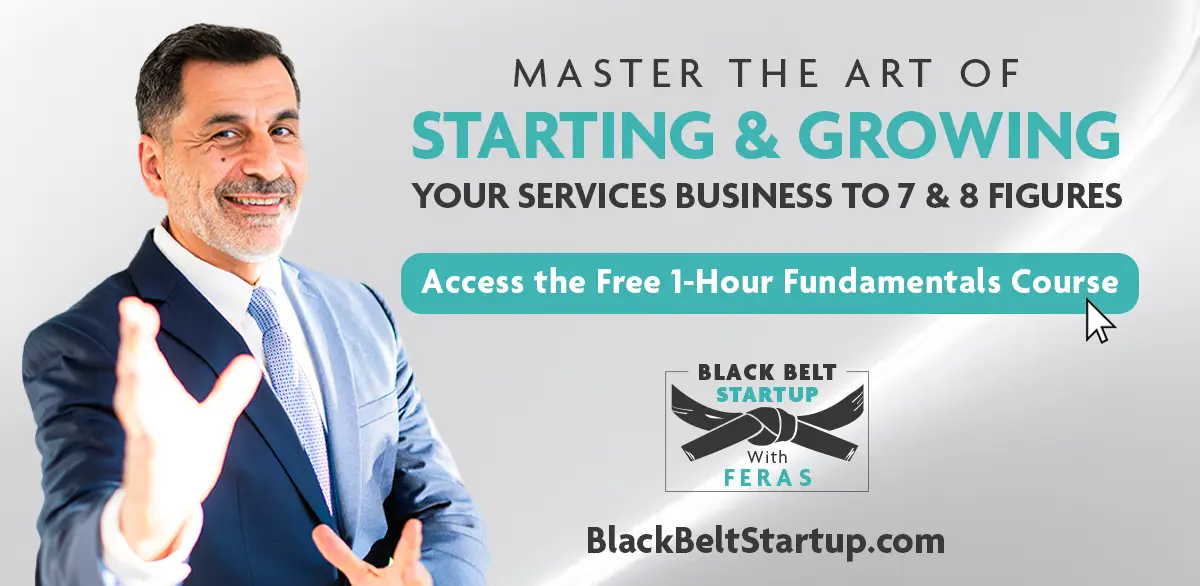Before You Get Laid Off (Or If You Already Are)

Good Morning!
This past Wednesday, I had the chance to speak at SCORE Silicon Valley to a group of 50+ entrepreneurs about effective pricing models and strategies. It turned into a super engaged 90-minute session with great questions. There’s nothing more rewarding than hearing, “That makes so much sense—I’m using this on my next sales pitch!”
On the Mat
- When the Job Goes… Now What
- Turning a Proven Model into a Scalable Business
- 3 Things You Need to Know About Building a Company That Lasts
- 10 Reasons Why 99% of Businesses Fail
Let's Train
The Job Is Gone… Now What?
The CEO walked into the room and said, “Feras, do you have a minute?”
I knew. I’d heard the rumors.
One day later, more than 50% of the company was gone. Syndeo had burned through a sizable chunk of the $96 million it raised, and I — VP, husband, father of three, was officially laid off.
It was one of the worst days of my life.
But that’s not where the story ends.
That layoff became the first domino in a chain that led to multiple consulting businesses, a team of co-founders, and eventually an 8-figure exit.
I didn’t plan for it. But I did act.
Most people default to a job search when they get laid off. And there’s nothing wrong with that. But I want to offer a different lens:
A layoff might be your first real shot at owning your work life.
You already have something valuable: experience, insight, and domain expertise. You’ve solved real problems inside companies. Why not take that knowledge and turn it into a service?
Here’s what I recommend if you're up for the challenge of entrepreneurship:
- Cut your expenses — build a financial runway. 3–6 months if possible.
- Package your skill — pick one pain point you’re great at solving. Build an offer around it.
- Land your first client — reach out to everyone. Undercharge if you have to. Just get that first “yes.”
This path won’t be easy. But it’ll be yours.
And if you’re still in a job that feels “off,” don’t wait for a layoff. Start building now, while the stakes are lower.
You don’t have to wait for someone to fire you to take yourself seriously.
Ask Feras Recaps
Turning a Proven Model into a Scalable Business
Now with a full team and consistent revenue, they were facing a classic inflection point: What’s next?
🔥 Challenge:
Ann & Ron cornered their niche in digital marketing education, but they’re feeling the limits of their current model. Growth is constrained by time, cash flow, and operational complexity. They’re wondering whether they should raise capital, launch a new platform, or position the business for a future sale.
💡 What They're Already Doing Right:
They’ve developed a repeatable content production engine, own their intellectual property, and are generating steady income through both content licensing and consulting. Their system works — and they’ve proven it at scale.
🛠️ Solution:
I proposed two moves:
- Expansion into new verticals: Leverage their content engine to serve another industry—something like sustainability or healthcare. It’s the same playbook, just applied to new audiences.
- Clear operational focus: Growth requires mental space. I encouraged them to delegate or outsource operational tasks to free themselves up for strategic thinking and execution.
I also shared with them a bonus idea: Package their internal process as a service. Their production system is gold — others would pay to learn how to build that same system in-house.
📈 Progress
They’re now mapping out a test expansion into a new vertical, while exploring opportunities to productize their behind-the-scenes process. It’s a smart way to scale without abandoning what already works.
* Some details have been changed to protect privacy and enhance storytelling.
You Might Like This
In 3 Things You Need to Know About Building a Company That Lasts, Entrepreneur contributing writer William Louey places tech adoption at the center of long-term business success. He emphasizes the importance of building around technology that emphasizes learning and celebrates successes.
He emphasizes the importance of learning and team support for tech adoption. My own guidance goes a bit further in this direction, especially for very new businesses:
- Success of tech in business comes 90% from people and processes and just 10% from the technology itself.
- As a corollary, you can in many cases start your business or a new business function with low-cost or no-cost technology. (An example would be my Google-sheet-based DIY CRM, which you could use in the earliest stages of your business before implementing a dedicated CRM.)
This is true for the AI wave as well. It's imperative that businesses take advantage of AI, but start with implementing simple, day-to-day efficiencies and empowering your team through a positive culture for learning, innovation, and achievement.
Sharpen Your Blade
My partner and I told ourselves we were “waiting for the right moment.”
Truth is, we were just scared to sell. Looking back, it wasn’t a strategy. It was avoidance dressed up as planning.
We kept tweaking the offer, refining the pitch deck, playing with the logo. Anything but actually talking to potential clients. Because rejection felt worse than standing still. And “almost ready” felt safer than hearing “no.”
But here’s what I’ve learned the hard way:
Most businesses don’t fail because of competition.
They fail not from outside pressure, but from inside patterns.
- Not landing enough clients?
- Reworking every project for hours?
- Hearing crickets after sending a proposal?
It’s not random. It’s not the algorithm. And it’s definitely not just bad luck. It’s usually one of 10 subtle patterns founders fall into without realizing. Patterns that feel productive, but actually kill your momentum.
Like:
- Delaying the ask because you fear rejection
- Doing everything solo (and burning out quietly)
- Saying “yes” too much because your prices don’t match your value
- Planning endlessly instead of getting real-world feedback
They’re the sneaky ones that quietly kill your confidence and keep you stuck. If you’re tired of second-guessing yourself and wondering what you’re doing wrong
This video could save you years of wasted effort.
Subscribe to the Black Belt Startup Newsletter
Weekly, 5-minute insights to help you escape the 9–5, land your first clients, and grow a thriving business.


